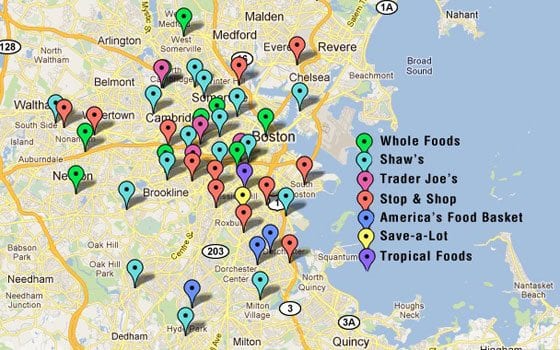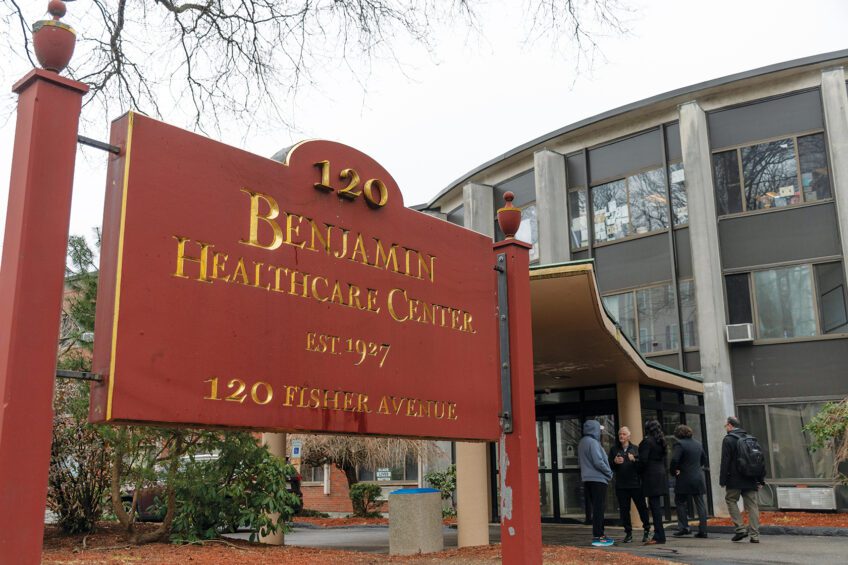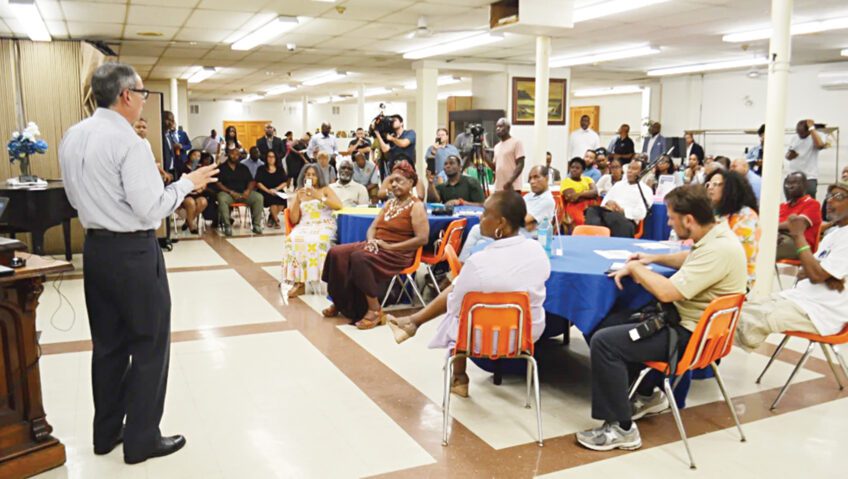
Healthy food is in short supply in communities of color
Leonard Lomax travels for an hour and a half to get to a grocery store. Without a car, the 58-year-old Dorchester resident rides the bus to get to a Stop and Shop where he can buy healthy food.
Throughout his life, Lomax lived on a diet of cake, candy, potato chips and other junk foods. “I like the way it tasted because I didn’t have anything else in mind to eat,” he said. Finding these foods was never difficult — he could always buy them at nearby corner stores.
After his teen years, Lomax’s weight quickly ballooned from 119 pounds to 270, and even after he worked to lose most of this weight, he was diagnosed with diabetes.
With his new disease, Lomax knew he had to change his eating habits. “I think I made a good choice by what I have to do to be in control of my diabetes — to eat the right food,” he said. “My advice for other people is to do the same thing, even if you’re not diabetic.”
But change is difficult when the nearest grocery store is so far away.
“Some of the challenges that I’ve observed for many families is that there isn’t always a supermarket or a grocery store that provides fresh produce that they can easily access,” City Councilor At-Large Ayanna Pressley said. “While we do have an excellent public transportation system, sometimes it can feel as if there’s a food desert.”
According to Boston Public Health Commission data, Roxbury and Dorchester have fewer grocery stores per capita than other neighborhoods in Boston. Roxbury has a grocery store for every 16,783 residents, and Dorchester has a grocery store for every 20,803 residents. These rates are nearly half that of the Fenway/Kenmore neighborhood, which houses a grocery store for every 9,941 residents. Mattapan has no full-service grocery stores within its borders.
This disparity is even more pronounced when compared to Central Square in Cambridge. Within walking distance from the Square are two Whole Foods, a Trader Joe’s, a Shaw’s, the Harvest food co-op and a few smaller grocery stores. This small neighborhood has nearly the same number of grocery stores as all of Roxbury and Dorchester combined.
The Boston food landscape mirrors national disparities in physical food access. According to a PolicyLink report, low-income neighborhoods have half the number of grocery stores as the wealthiest neighborhoods, and predominantly white neighborhoods have four times the number of grocery stores as predominantly black neighborhoods. Only 8 percent of African Americans nationwide live in a census tract with a grocery store.
The U.S. Department of Agriculture also reports that 23.5 million people live in low-income neighborhoods more than one mile from a grocery store. These individuals spend nearly 20 minutes longer traveling to a grocery store than the national average of 15 minutes.
Another study conducted in Brooklyn, N.Y., assessed the availability of produce in stores, and found that fresh fruits and vegetables were more widely available in white neighborhoods than in neighborhoods of color.
Lomax’s experience certainly feels like that of a food desert, as Councilor Pressley said. But the U.S. Department of Agriculture does not include Roxbury or Dorchester in this category. After all, these two neighborhoods have a handful of chain grocery stores — Stop and Shop, Shaw’s, America’s Food Basket, Save-a-Lot — and boast the highest number of community gardens in the entire city.
“Boston is a better place than many cities on availability of full-service supermarkets,” said Anne McHugh, division director of chronic disease at the Boston Public Health Commission. “But it is not perfect at all.”
“Food deserts,” areas that lack access to healthy food, have become the most common way of measuring food inequality in the United States. For example, a signature component of Let’s Move, the first lady Michelle Obama’s anti-obesity campaign, is tackling food deserts.
“Our goal is ambitious,” Obama said in a promotional video for her campaign. “It’s to eliminate food deserts in America completely in seven years. With a modest initial investment of about $400 million a year, we’re going to use that money to leverage hundreds of millions more from private and nonprofit sectors to bring grocery stores and other healthy food retailers to underserved communities all across this country.”
While an important term, the measure of food deserts alone is insufficient to capture the full picture of culinary inequality in the United States and Boston. Roxbury and Dorchester are not technically food deserts, but clear discrepancies exist between these two neighborhoods and others in and around Boston.
Cambridge and Fenway/Kenmore, for instance, offer a variety of grocery stores — high end and cheaper ones — and each of these stores is centrally located, easy to walk to and close to public transportation. Roxbury and Dorchester, by contrast, offer only regular and discount grocery stores, and each of these is typically located on the edges of the neighborhood.
The map illustrates this pattern. Stop and Shop and Shaw’s are two of New England’s largest grocery store chains and have numerous locations throughout the Greater Boston area. With the exception of the Stop and Shop in Grove Hall, these two chain stores are only located on the periphery of Roxbury and Dorchester, forming a ring around the two neighborhoods. Whole Foods and Trader Joe’s, two high-end national grocery chains that stock natural and organic products, are not even on the edges of these neighborhoods — the closest of either stores is the Whole Foods on Westland Avenue near Symphony Hall and the recently opened one in Jamaica Plain on Centre Street.
In addition to these grocery chains, Roxbury features Tropical Foods and Save-a-Lot, both near Dudley Square, and Dorchester hosts two America’s Food Basket locations. While these are more central than the large-scale chains, large segments of Roxbury and Dorchester are still a considerable distance from any grocery store, leaving residents like Lomax a 90-minute bus ride away from these healthy food options.
Food quality is another area of discrepancy. The Whole Foods in Fenway is pristine, bright and inviting, with fresh flowers and herbs always on display, and offers indoor and outdoor seating options for customers. The store is always bustling with activity and in addition to being a food retailer, also serves as a hangout spot. America’s Food Basket on Geneva Avenue, on the other hand, has major cracks in its glass doors, a security guard who asks customers to check their bags at the door, dirty floors and dim lighting.
The same Whole Foods in Fenway also boasts a range of high-quality foods like fresh organic and local produce, wild-caught fish, artisanal cheese and fresh deli meats. While considerably more expensive than other stores, the food on display at Whole Foods looks healthy and delicious.
By contrast, much of the healthy food selection at the Stop and Shop in Grove Hall looks unappetizing. Shriveled red potatoes, dirty lemons and bruised oranges pocked with decay are prominently on display in the produce section, raw salmon and catfish fillets are gray-colored, and several fried and frozen chicken breasts have noticeable freezer burn. To be fair, not all of the fresh food is unappetizing — the greens look lovely — but enough poor quality food on display surely makes healthy eating an unappealing option.
Local focus groups conducted by a private firm revealed that in the six Boston neighborhoods with the highest rates of chronic disease and obesity — Jamaica Plain, East Boston, Roxbury, North Dorchester, South Dorchester and Mattapan — residents with cars are commuting to grocery stores outside their neighborhoods to find higher-quality food at lower prices.
These discrepancies in store location and quality demonstrate that not all grocery stores are equal — also suggesting that not all grocery stores will be the solution to the access problem.
Scientific research also offers mixed conclusions on the health effects of the accessibility gap. One cross-sectional study cited in a PolicyLink report shows the direct relationship between grocery store access and a healthy diet, particularly for African Americans. For each additional grocery store per census tract, fulfillment of the U.S. Department of Agriculture’s nutritional guidelines for fruits and vegetables increased 32 percent for blacks and 11 percent for whites.
Similarly, the American Journal of Preventive Medicine published a literature review of cross-sectional studies on this topic and found, “In general, research suggests that neighborhood residents who have better access to supermarkets and limited access to convenience stores tend to have healthier diets and lower levels of obesity.”
However, a new study released several months ago challenges these conclusions. Published in the Journal of the American Medical Association (JAMA), the longitudinal study — meaning it followed the same cohort of subjects over an extended period of time, opposed to cross-sectional studies, which examine a large population only once — concluded, “Neighborhood supermarket and grocery store availability were generally unrelated to diet quality and adherence to fruit and vegetable recommendations.” The presence of a grocery store did not lead to a better diet.
While this study ignored important factors like food prices and quality that would have a clear impact on consumers’ purchases, the results point to the complexity of the access question.
Just as a grocery store — any grocery store — is not the sole indicator of equality in a neighborhood, grocery stores alone are also not the magic bullet in remedying the nation’s poor diet. Underserved communities need more than just any grocery store in their boundaries — they need stores that are accessible, fairly priced, inviting and high quality, too. Each of these factors contributes to demand, what the JAMA study showed was missing from its subjects.
For Lomax, who now must monitor his sugar level and take pills multiple times a day, the physical discomfort of diabetes has not yet begun. But those of living far from a grocery store have. “Right now my joints are bothering me,” he said. “I think I’m doing too much walking. I’ve been walking around because I don’t drive.”
When asked how frequently he can get to the nearest grocery store, he responded, “I don’t go too much.”
Next week’s installment will address the challenges of fast food in Boston. This series was funded by the University of Southern California National Health Journalism Fellowship.






